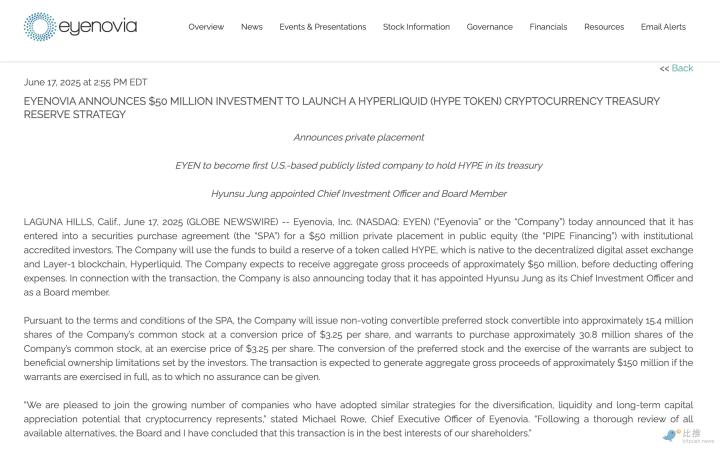Author: Mario @IOSG
TL;DR
- Hyperliquid is an extremely fast on-chain perpetual contract DEX that runs on its self-developed Layer 1, providing centralized exchange-level performance while maintaining on-chain transparency.
- Its native token $HYPE is responsible for network governance, can reduce transaction fees after staking, and capture value through listing auction repurchase.
- The core liquidity of the protocol is HLP Vault, a hybrid vault that combines market makers and liquidators, accounting for more than 90% of TVL
- In March 2025, Hyperliquid encountered a serious black swan event: $JELLYJELLY manipulation event, which almost triggered a chain liquidation of the entire vault
- The incident exposed the centralization problem of validator governance: Hyper Foundation intervened to avoid collapse, which ensured survival but triggered controversy over decentralization
- However, after the crisis, Hyperliquid quickly rebounded with whale stickiness and ecological expansion, setting new highs in trading volume, open interest and $HYPE price
- Today, the platform (including HyperEVM) has launched more than 21 new dApps, covering NFT, DeFi tools and vault infrastructure, with functions far beyond perpetual exchanges

Where are the “Degen” whales trading?
James Wynn is a well-known degen in the crypto community. He is an anonymous whale who turned $210 into $80 million in three years. His most famous achievement is turning $7,000 $PEPE into $25 million, and he has been using 40x leverage to make nine-digit positions for many years. [1]

Wynn often publicly displays his entry positions, responds to market fluctuations in real time, and even ignores eight-digit liquidations. But the real key is not who Wynn is, but where he trades.

Hyperliquid is the new arena for Wynn and all high-leverage, high-position degens. Anonymous whales (such as "Insider") trade large positions on Hyperliquid, and their positions are now regarded by Chinese crypto media as a barometer of real-time market sentiment and platform dominance.
So how did Hyperliquid get to this point? Why do high-risk traders choose it?
Let’s disassemble them one by one.

What is Hyperliquid?
Hyperliquid is a decentralized exchange, but it does not adopt the AMM model like Uniswap.
It uses a completely on-chain order book mechanism, and does not set prices through liquidity pools, but through on-chain matching, providing a real-time trading experience similar to CEX. Limit orders, transactions, order withdrawals and liquidations all occur transparently on the chain, and settlement can be completed within one block.

Hyperliquid has built its own Layer 1 blockchain, also named “Hyperliquid”, designed for high performance. This allows it to execute trades with the speed and stability required by high-frequency traders.
This performance is not an empty promise. By June 2025, Hyperliquid’s share of the on-chain derivatives market reached 78%, with a daily trading volume of more than $5.5 billion. [2]

$HYPE
Hyperliquid is not just a trading platform, but also a complete on-chain financial system, and its core token is $HYPE.
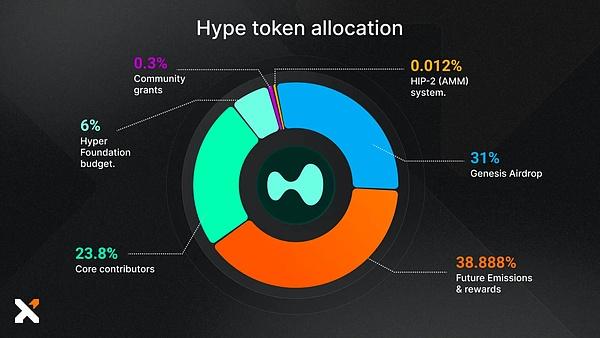
Tokenomics and philosophy
$HYPE has a total supply of 1 billion, which was distributed to approximately 94,000 users through a large-scale airdrop (310M, 31%) in November 2024. It is one of the projects with the most realistic user distribution in recent years. [3]
A total of 70% is allocated to community airdrops, incentives and contributors: no VC. This is a clear idea from the founder Jeffrey Yan, a Harvard mathematics graduate and former high-frequency trading engineer at Hudson River Trading.
Yan has publicly stated that “letting VCs control the network would be a scar.” He hopes to build a financial system that is “built by users and belongs to users.” [4]
This "community first + protocol performance" concept is also reflected in the mechanism design of $HYPE: it is not only a governance tool, but also a practical token.
Utility
In addition to its governance function, $HYPE is also directly used to reduce transaction fees. Users can stake $HYPE to get a fee discount.

In addition, $HYPE is also the core of network security. Hyperliquid runs on the Proof-of-stake consensus mechanism. Staking $HYPE is not just for reducing fees or earning rewards, it is the basis of the entire block production mechanism.
To become a validator, you must meet the following requirements:[5]
- At least 10,000 $HYPE staked
- Pass KYC/KYB identity verification
- Build a high-availability infrastructure (including multiple non-validating nodes)
- Node performance will be continuously monitored and stake distribution will be managed through the Hyper Foundation's delegation program.
The current annualized staking income for validators is approximately 2.5%, and the yield curve is designed based on the Ethereum model.

Other Features of Hyperliquid
a.HIP-1 Auction Mechanism: Decentralized Coin Listing Process
One of Hyperliquid’s most unique and often underestimated mechanisms is its auction-based listing system: HIP-1.
This mechanism determines the listing eligibility of new tokens through an on-chain Dutch auction:
- The starting price is twice the last transaction price;
- The linear decline lasted for 31 hours, reaching a low of 10,000 USDC;
- The first wallet address that accepts the current price will obtain the right to create and list the Token.
Unlike centralized exchanges (such as Binance and Coinbase) that operate in a black box and charge high listing fees, HIP-1 listing is completely transparent, requires no negotiation, and has no insider allocation.
For example, at the end of 2024, the CEO of Moonrock Capital accused Binance of demanding 15% of the tokens from a Tier 1 project as a listing fee (approximately $50 million to $100 million). Coinbase was even rumored to require up to $300 million in listing fees. [6]
Even if Binance launches the "Batch Vote to List" mechanism, there is still the opaque problem of voting for 2 projects on the list but actually launching 4 projects.
On Hyperliquid:
- The auction process is fully on-chain and executed entirely by smart contracts;
- 100% of the listing fee will go into the Assistance Fund and be used to repurchase and destroy $HYPE;

- There is no team commission and no reserved spots.
Compared to other protocols that mostly collect listing fees from teams and VCs, Hyperliquid’s fee distribution logic is:
- All costs are funded by the community: shared between HLP, the aid fund, and spot publishers.[7]

However, despite the transparency of the mechanism, Hyperliquid’s spot market still has obvious problems:
- Most auctions were sold at close to the reserve price (e.g. $500 HYPE), reflecting the limited market interest in spot listings.

- The trading volume of tokens after going online is extremely low;

- The official page does not clearly mark the new coin information, resulting in low attention;
- The current spot market accounts for only 2% of the total spot trading volume on DEXs, of which 84% is the $HYPE/USDC pair.


If Hyperliquid wants to truly challenge the listing status of centralized exchanges, it must improve UI visibility, activity and linkage with the secondary market.
b. Vault mechanism
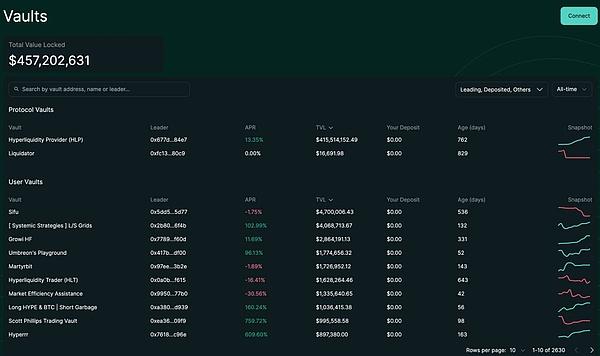
Hyperliquid not only serves active traders, but also provides users with a way to passively earn income through the vault system, allowing funds to participate in algorithmic trading strategies.
There are currently two types of vaults:
- User-created Vaults: Anyone can create a vault and use the pool to trade. Investors share profits and losses in proportion, and vault managers can charge 10% of profits as management fees. To ensure that interests are aligned, managers must pledge no less than 5% of the vault's TVL (total locked value). This model is similar to the "Copy Trading" of centralized exchanges.
- HLP (Hyperliquidity Provider): The HLP vault runs market-making strategies on Hyperliquid. Although strategy execution is currently still carried out off-chain, its positions, pending orders, transaction history, deposits and withdrawals, and other data are all publicly available on the chain in real time and can be audited by anyone. Anyone can provide liquidity to HLP and share profits and losses in proportion. HLP does not charge any management fees, and all profits and losses will be distributed in full proportion to each provider's share in the vault. [8]
Currently HLP accounts for 91% of Hyperliquid’s total TVL. Its strategies are divided into two categories:
#Market Making:

- Continuously post buy/sell double-sided quotes;
- Earn the difference between buying and selling prices (spread).
Liquidator:

- When the user's margin falls below the maintenance margin, the platform attempts to place a limit order to close the position;
- If the position is less than 66% of the maintenance margin, the system will call the liquidation vault to take over the position;
- HLP attempts to close positions at a limit price to reduce slippage and risk;
- If the risk is too great and cannot be controlled, the Auto-Deleveraging (ADL) mechanism will be triggered to force position reduction.
In summary, HLP = market maker + liquidator.
- As a market maker, HLP continuously provides liquidity (two-sided quotes);
- As a liquidator, HLP takes over the liquidated user's positions and reduces their positions.
summary
The revenue structure of the Hyperliquid platform is as follows:

- Transaction fees (Taker/Maker): distributed to HLP depositors;
- Auction and spot transaction fees: 100% goes to the assistance fund to buy back and destroy $HYPE;
- There is no team commission/financial fee deduction, which is different from most DEXs.
HLP Performance
We measure HLP's actual protocol revenue through "Hedged PnL". This data does not include position gains or losses caused by market fluctuations, but only includes:
- Taker/maker transaction fees;
- Funding rate income;
- Clearing fees, etc.

Therefore, it reflects the true “Alpha” capabilities of the protocol.
Data shows that in the 2025 rally, HLP's daily net position was usually negative, indicating that it was short the market most of the time. This is because the platform placed a large number of limit buy orders, and HLP passively accepted sell orders, resulting in an overall short exposure.

In March, we can clearly see a huge spike, with net notional exposure close to -$50 million. This is exactly when Hyperliquid was almost destroyed on the day of the $JELLYJELLY incident.

Hyperliquid’s exposure
Risk concentration issues of HLP
As mentioned earlier, HLP accounts for more than 90% of the TVL on Hyperliquid, and is also the main source of liquidity and liquidation for the platform. Such a high concentration poses a systemic risk: once HLP fails, the entire platform may collapse.
We can see that HLP TVL accounts for about 75% of the total TVL of the entire hypeliquid chain.

This was exposed starkly in the $JELLYJELLY incident in March 2025. The incident was a carefully manipulated attack that almost caused a systematic chain liquidation of the entire HLP vault.

The incident process is briefly described as follows:
- $JELLYJELLY is a meme + ICM project on Solana. Its market value was as high as $250 million, but later fell to $10 million. Its liquidity is extremely low.
- The attacker deposited 3.5 million USDC on Hyperliquid;
- Opened a short position of $JELLYJELLY at $0.0095, with a short amount of approximately $4.08 million;
- At the same time, a large amount of spot goods were purchased, causing the spot price to soar;
- Then withdraw the margin, causing the position to be liquidated, and HLP takes over the short order;
- There is no counterparty in the market to buy the order, so HLP passively holds a huge short position;
- At that time, the loss of open positions was as high as $10 million. If the price continued to rise, it would trigger a chain reaction of liquidation on the entire platform.
Ultimately, Hyperliquid issued an emergency announcement, saying it had encountered "abnormal market behavior" and quickly coordinated validators to vote to remove the JELLY contract and force liquidation.
But the key point is: the closing price is not the on-chain price, but the internal price of $0.0095, which is equivalent to manually marking $JELLYJELLY as a drop of 80%.

Although this allowed HLP to escape with a small profit, it also raised strong governance questions:
- Who can manually change the contract execution?
- Can Oracle pricing be trusted?
- If a contract can be delisted, is there any point in decentralization?
- Is validator governance a dead end?
This incident not only challenges the stability of HLP, but also shakes the decentralized foundation claimed by Hyperliquid.
During the $JELLYJELLY liquidation process, the Hyperliquid validator group quickly coordinated:
- Stop contract trading;
- Overwrite oracle data;
- Manually remove assets and force close positions.
But here’s the fatal reality: most validators have a direct relationship with the Hyper Foundation.

According to on-chain data, as of the time of the incident:
- Hyper Foundation controls 5 of the 16 validators;
- The total pledged amount accounts for 78.5%;[10]

- Even as of June 2025, it still controls about 65.3% of the pledge ratio.

Therefore, the so-called validator governance is essentially closer to an “internal emergency response mechanism” rather than true decentralization.
The community has also pointed out: Since it is possible to forcibly delist assets and change prices, is Hyperliquid just "DEX architecture + CEX execution"?
Although this centralized governance avoided a systemic collapse, users began to question Hyperliquid’s long-term credibility. After the incident, HLP’s TVL declined significantly, and users withdrew funds to avoid risks.


How did Hyperliquid recover so quickly from the crisis?
In the field of encryption, being questioned is not fatal, but being "replaced" is.
After the short squeeze in March 2025, Hyperliquid's HLP vault was almost emptied, and the governance mechanism was also caught in a centralized controversy. At the time, many people believed that it was doomed. On April 7, $HYPE fell to $9, and the market was full of FUD and concerns about vault risks.
However, just over a month later, $HYPE rebounded strongly to over $35, setting a new all-time high and re-entering the ranks of the top 20 crypto assets by FDV.
What made Hyperliquid turn defeat into victory?

Whale never leaves
Even at the most intense moment of the $JELLYJELLY incident, Hyperliquid still maintained about 9% of Binance’s perpetual contract trading volume. This is not only data, but also a signal:

Despite the platform's trust crisis, institutional traders, whales and KOLs continue to use Hyperliquid.
Why? Because it meets the core needs of the current market:
High-performance derivatives trading + no KYC required + extremely capital efficient.
Unlike centralized exchanges like Binance or OKX, these platforms:
- Require identity verification;
- Restrict access to certain areas;
- Sometimes even user assets are frozen.
Hyperliquid provides freedom while still maintaining CEX-like matching speed and depth.
Therefore, it is very attractive to users who:
- Whales seeking anonymity and leverage;
- Institutions that require programmatic trading (e.g. Binance in Hong Kong cannot obtain API authorization Type 7);
- Rely on transparent transaction records to create influential KOLs: forming a "capital + voice flywheel".

Even after the crisis, these users not only did not leave, but became more active. The meme coin market driven by James Wynn and others has made Hyperliquid the core battlefield for on-chain speculation.
In fact, the $JELLYJELLY incident proves one thing:
Hyperliquid is the only on-chain platform that can withstand the same blows as centralized exchanges.
Even if whales are bearish, they have nowhere to escape, because currently the only one with sufficient depth to support their operations is still Hyperliquid.

The Real Tradeoff: Decentralization vs. Control
Hyperliquid has never claimed to be "pure DeFi". Its goal is to be an experience-based DEX with "users at the core".
Therefore, it made a pragmatic trade-off: sacrificing some governance decentralization in exchange for high-throughput, low-latency execution performance.
This is controversial, but it clearly works.
As Foresight News put it:[12]
“To survive the black swan, someone has to hold the sword.”
Hyperliquid has made it clear that it is willing to be the “sword bearer” and when the protocol encounters a cascading crisis, it chooses to save its life through manual coordination and upper-level intervention.
This is not censorship; this is operational resilience.
Take Sui Network as an example: On May 22, 2025, Sui's validators voted to pass a proposal to forcibly recover $220 million in assets stolen from the DEX aggregator Cetus. The proposal allows validators to override wallet control and revoke hackers' access to $160 million of frozen funds. The entire operation was called "hacking the hacker" and sparked heated debate.
This "hacker-counterattack" has sparked widespread controversy: some critics say it violates the DeFi creed, while others say it is a necessary measure for the system to save itself.
So is Sui decentralized? Probably not.
But that’s exactly the point: every high-performance blockchain has to make trade-offs.
Speed, liquidity, UX, protocol security — it is impossible to maximize them all at the same time.

The key question is: Are these trade-offs transparent and effective?
Hyperliquid's validators are mostly controlled by the Hyper Foundation, which poses a centralization risk. But this is also the reason why it can respond quickly to the $JELLYJELLY crisis.
Users vote with their wallets: Even with the FUD, Hyperliquid’s open interest, TVL, and fee income all hit record highs in May.
In a real emergency, most users don’t care whether the system is “perfectly decentralized” or not; they only care about: Can this system save me?
Not just DEX, but also an on-chain ecosystem
Although governance remains centralized, Hyperliquid is no longer just a derivatives platform.

According to Cryptorank data, 21 new projects have been deployed on Hyperliquid in the past three months, and the total number of ecological projects exceeds 80, covering:
- DeFi
- GameFi
- NFT
- Development Tools
- Analytics Platform

The Milady series NFT project was also released on its chain, called Wealthy Hypio Babies, and the floor price continued to rise, reflecting the strong stickiness of the chain's native liquidity and the strong spontaneous interest of the community.
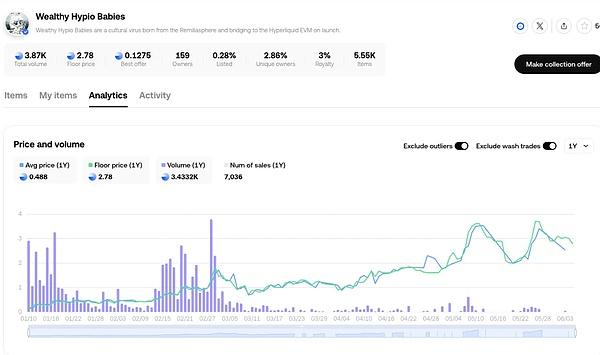
Even after experiencing governance disputes and large-scale liquidation crises, developers and users continue to bet that Hyperliquid is a Layer1 with excellent performance and prospects.

Hyperliquid's real growth momentum
Why DEX?
Centralized exchanges (CEX) frequently collapse and user trust continues to erode, accelerating the migration to DEX.
- FTX’s collapse in 2022 shows that top exchanges can also collapse overnight and freeze user assets;
- In the past decade, CEX has suffered 118 hacker attacks, with cumulative losses exceeding $11 billion, far exceeding on-chain attacks;
- Every withdrawal suspension and asset freeze reminds users that the custody platform has natural third-party risks.
As payment infrastructure improves, many people may no longer need to withdraw fiat currency in the future.
In 2024, the number of self-hosted wallet users surged by 47%, with active addresses exceeding 400 million; in January 2025, DEX trading volume hit a record high. Users vote with their feet, turning to self-holding assets and on-chain transactions.
The original intention of blockchain is: decentralization, autonomous control of assets, and no need to trust intermediaries. However, in the past, many people used CEX as a wallet for convenience, ignoring the essence of "not your keys, not your coins".
Today, this perception is changing. As infrastructure matures and on-chain opportunities increase, self-custody is not only a means of security, but also an entry point for "early participation and high returns", such as airdrops and meme coins.
For example: $TRUMP was over $20 when it was listed on CEX, but the early purchase cost for on-chain users was much lower than this.
This trend shows that convenience often means missing out, while control is proactive.
In the future, moving from centralization to on-chain will no longer be a matter of concept, but a choice between benefits and efficiency.
Why Hyperliquid?
Even after the $JELLYJELLY crisis, users still stayed with Hyperliquid, and DEXs such as dYdX and GMX did not divert users.
Hyperliquid did three key things right:
A truly community-oriented token model
Hyperliquid is one of the very few DeFi projects that was launched without VC investment.
- No early distribution, no private placement round;
- Over 70% of $HYPE was allocated to the community, with 31% airdropped to 94,000 addresses, averaging ~$45,000 per wallet.
This has three major effects:
- Established a sticky user base through Season 1/2 point farming;
- There will be a stable repurchase after launch (such as dydx without such mechanism);
- There is no pressure on VC to unload (comparison: over 50% of dYdX is allocated internally, and over 30% of GMX).
To sum up: users are not just users, but also "owners".
CEX-level trading experience, without CEX risk
Hyperliquid achieves: Binance speed, on-chain deployment.
- GMX has AMM inefficiencies;
- dYdX v3 is off-chain matching;
- The UI/UX lag is noticeable.
This attracts whales (such as James Wynn, who holds over $1 billion), market makers, and HFT high-frequency traders.
Even after the crisis, Hyperliquid's depth and slippage control still remain ahead (slippage is only ~0.05%).
Product Depth: More Than Sustainability
In early 2025, Hyperliquid launched several new modules:
- Launched spot market;
- Release HyperEVM for DeFi developers;
- Launched HLP vault and copy trading system;
- Launched the meme coin standard (HIP-1), supporting spot + perpetual integrated transactions;
- Establish a risk fund supported by real-time rates (for $HYPE buyback and destruction).
These constitute the “all-in-one DeFi trading platform”:
- Trade BTC spot, ETH perpetual, and meme coins on one UI;
- You can participate in HLP, or copy top traders;
- One wallet handles all operations, fast, cheap, and gas-free.
In contrast, dYdX or GMX are more like a "single protocol", while Hyperliquid has already evolved into a multifunctional ecosystem.

In-depth analysis of the HyperEVM ecosystem
HyperEVM is a smart contract layer launched by Hyperliquid, which supports EVM-compatible dApp construction and forms a three-layer architecture with the core transaction layer HyperCore and the consensus layer HyperBFT:

- HyperCore: Core assets and matching engine. All assets enter here first, which is equivalent to the "exchange balance".
- HyperEVM: Smart contract execution layer, supporting DeFi, NFT, GameFi and other modules.
- HyperBFT: Based on HotStuff's BFT consensus mechanism, it optimizes low-latency, high-throughput transaction execution.
Assets must be manually transferred from HyperCore to HyperEVM to interact with smart contracts, and gas fees are paid by $HYPE.
How to enter the HyperEVM ecosystem?
External Chain → HyperCore → HyperEVM
a. External links → HyperCore
Commonly supported chains include Ethereum, Arbitrum, Solana, and Bitcoin, and supported assets include USDC, ETH, BTC, SOL, etc.

b. HyperCore → HyperEVM

External chain → directly transferred to HyperEVM (such as using deBridge)


Popular projects on HyperEVM
DEX (non-perpetual)
- Hyperswap: Supports new coin listings and provides liquidity mining incentives

- Liquidswap: Aggregate DEX, unified routing of multiple pools
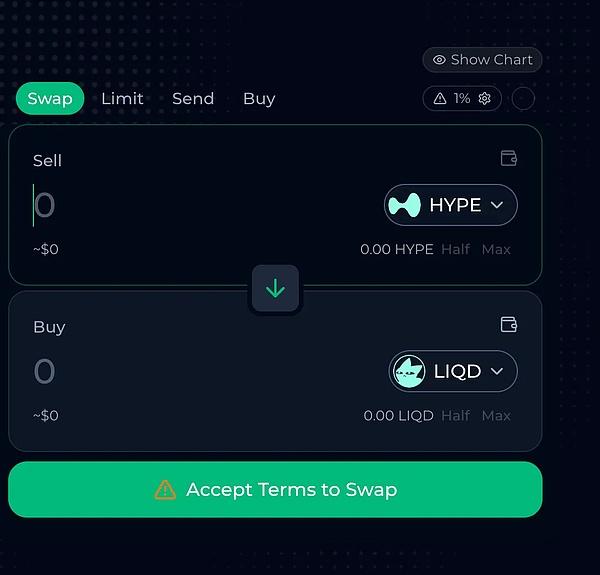
DeFi Protocols
- Hyperlend / Felix / Hypurr.fi: Supports multiple combinations of lending, LP, etc.



#Launchpad
- Liquidlaunch: An early-stage project launch platform

Why is HyperEVM important?
As DeFi, stablecoins, NFT and other protocols are continuously deployed on HyperEVM, on-chain transactions are becoming increasingly active, and the consumption of $HYPE as a gas payment token is also increasing, forming a deflationary logic. All gas fees (including basic fees and priority fees) will be destroyed.

In addition, future airdrops may also refer to EVM activity to further promote user and developer migration.
This means that HyperEVM is not just a functional complement, but brings real network effects and narrative flywheels:
New project deployment → Increase gas consumption → Support $HYPE Value → Attract more users → Attract more developers → Repeat

Potential high beta project: Ecological token
While $HYPE remains the core asset that captures the value of the Hyperliquid system, emerging tokens on the HyperEVM (such as $LIQD, the governance and incentive token of the LiquidSwap ecosystem, which distributes $HYPE to stakers) provide higher beta exposure to ecosystem growth. These tokens typically represent:
- Localized revenue sharing model
- DeFi Basic Assets
- Early liquidity opportunities
As $HYPE appreciates in value, these tokens may benefit in several ways:
- Increased transaction volume and user inflow will improve token utility and fee capture capabilities;
- Increased APY denominated in $HYPE, such as that shown for $LIQD staking;
- Speculative upside as traders rotate into smaller ecosystem projects;
- Airdrops or governance incentives associated with early adoption.
In a high-speed compounding ecosystem like HyperEVM, this type of "water seller" token (gas fees driven by $HYPE, but not strongly correlated in token design) may relatively outperform $HYPE itself in the early cycles.
For example: If $HYPE doubles, and $LIQD with FDV < $100M increases in supporting depth, it is possible to increase by 4 times.

This type of token is not just a blood-sucking project, but rather an amplifier of ecological growth - more use → more gas → more HYPE destruction.
Form a flywheel positive cycle.

Conclusion
Although many people view Hyperliquid as “another DEX” or “emerging L1”, the fee data tells a different story:
Hyperliquid ranks seventh among all protocols in 30-day fees ($69.15 million), surpassing Tron, Solana, and even Staking leader Lido.
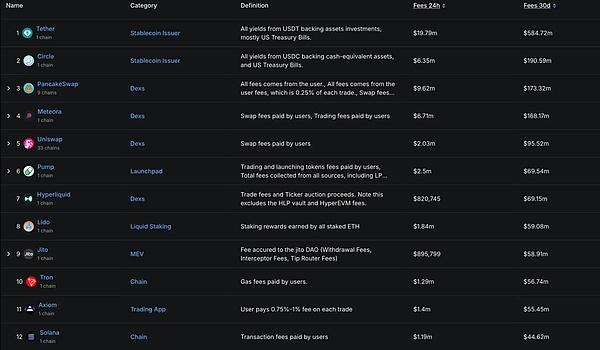
And this does not include the revenue from HLP Vault and HyperEVM, indicating that its revenue potential has not yet been fully realized.
From a valuation perspective, Hyperliquid's fundamentals are comparable to mainstream L1, but its real potential lies in becoming the first DeFi-native trading platform that can rival CEX in terms of trading experience, fees, and execution.
Most DEXs still rely on the swap model with poor liquidity, while Hyperliquid has built a real orderbook + HLP2 mechanism, with cross-chain slippage controlled within 0.3% and no need to frequently switch wallets.
We believe that Hyperliquid is becoming the only trading platform needed on the chain, from spot to perpetual, and then to the entire ecosystem.
In a sense, it is not aimed at defeating Uniswap, but directly targeting Binance.[16]

Why is it impossible for another Hyperliquid to be copied?
Even if you want to go all in on the next “explosive perpetual DEX,” I think the benefits of DEX are over.
Four reasons:
Market share crush
It accounts for 80% of the perpetual trading volume on the chain, with a weekly trading volume of more than $60 billion, forming a closed-loop flywheel of liquidity → users → liquidity. If new projects want to enter, they must first make up for billions of daily trading volume - which is extremely difficult.
An economic model that cannot be replicated
No VC, self-funded startup, not a meme, but building real trust and long-term consistency. New DEX needs financing, token issuance, reserved shares, background check disclosure, token incentives... The user structure is completely different.
Top founding team
The founders come from HRT, MIT, and Caltech, and they directly designed CEX-level infra with high-frequency backgrounds. The founder "Jeff" once revealed that his network of contacts was already senior traders, who became the earliest users and feedback sources. This kind of "moat" is difficult for others to copy.
Mature product ecosystem
Hyperliquid is not just a DEX, but a complete high-performance L1 - its underlying architecture, user structure, and governance model are self-consistent.




